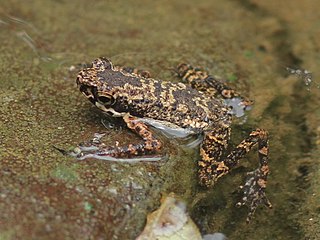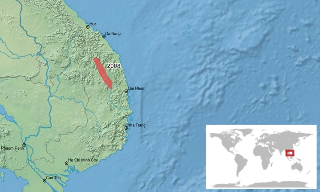Werneria, also known as the torrent toads or smalltongue toads, is a small genus of "true toads", family Bufonidae. They are found in western Central Africa, with the greatest species richness in the Western High Plateau of Cameroon. The species generally have restricted or patchy distributions and are considered threatened.
Sclerophrys taiensis is a species of toad in the family Bufonidae. It is known from the Taï National Park in southwestern Ivory Coast and from the Gola Forest in southeastern Sierra Leone; it is likely that its range extends into the adjacent Liberia. Common name Tai toad has been proposed for it.
Nectophrynoides poyntoni, also known as Poynton's forest toad, is a species of toad in the family Bufonidae. It is endemic to the Udzungwa Mountains in Tanzania and is only known from its type locality in the Mkalazi Valley. This species is only known from a single collection in 2003 and has not been seen ever since, despite targeted searches. Therefore, it is feared that it has strongly declined and might already be extinct.

Adenomus kandianus is a species of toad in the family Bufonidae endemic to Sri Lanka. It is a high-altitude species known only from few localities. The specific name kandianus means "from Kandy" and seems to suggest that the type material came from near the city of Kandy.
Malcolm's Ethiopian toad or the Ethiopian mountain toad is a species of toad in the family Bufonidae endemic to the Bale Mountains of Ethiopia. Its natural habitats are Astropanax–Hagenia–Hypericum montane forests and Afro-alpine moorland, and the transition zone in between. It is threatened by habitat loss and is listed by the IUCN as being an "endangered species".

Ansonia fuliginea, the North Borneo stream toad or North Borneo slender toad, is a species of toad in the family Bufonidae. It is endemic to Mount Kinabalu in Sabah, Malaysian Borneo.

Ansonia mcgregori is a species of toad in the family Bufonidae. It is endemic to central and western Mindanao, Philippines. The specific name mcgregori honors Richard Crittenden McGregor, an Australian ornithologist who collected the holotype. Common names McGregor's toad, McGregori's river toad, and McGregor's stream toad have been coined for it.
Ansonia platysoma, also known as the flat-bodied slender toad and Luidan stream toad, is a species of toad in the family Bufonidae. It is endemic to the island of Borneo and known from Sabah and Sarawak, Malaysia, and from Brunei. Its closest relative is Ansonia kelabitensis.
Rhinella chrysophora, sometimes known as the Rio Viejo toad, is a species of toad in the family Bufonidae. It is endemic to the Cordillera Nombre de Dios on the Atlantic versant in north-central Honduras.
Nectophrynoides minutus is a species of toad in the family Bufonidae. It is endemic to Tanzania and is known from the Uluguru and Rubeho Mountains. Common names small viviparous toad, minute tree toad, and dwarf forest toad have been proposed for it.

Pelophryne lighti, also known as the Mindanao flathead toad or eastern Mindanao dwarf toad, is a species of toad in the family Bufonidae. It is endemic to the Philippines.
Werneria tandyi, also known as Tandy's torrent toad or Tandy's smalltongue toad, is a species of toad in the family Bufonidae. It is endemic to western Cameroon and known from Mount Manengouba and from the Rumpi Hills. The specific name tandyi honours Robert Mills Tandy, biologist, herpetologist, and wildlife photographer.
Leptopelis susanae is a species of frog in the family Arthroleptidae. It is endemic to southwest Ethiopia and known from the Gughe Mountains and Saja Forest. The specific name susanae honours Susan, the wife of the describer, Malcolm Largen. Common names Susan's tree frog and Susana's [sic] forest treefrog have been coined for this species.
Leptopelis yaldeni is a species of frog in the family Arthroleptidae. It is endemic to Ethiopia and occurs in the montane highlands in Gojjam. Its range might be limited by the deep gorges of the Blue Nile. It is named in honour of Derek Yalden, a British zoologist who collected some of the types. Common names Yalden's tree frog and grassland forest treefrog have been coined for this species.

Leptobrachella tuberosa, also known as the granular toad, is a species of frog in the family Megophryidae. As currently known, it is endemic to the Central Highlands of Vietnam in Gia Lai, Quảng Nam, and Thừa Thiên–Huế Provinces. Its true range is probably wider as suitable habitat extends further north and east, reaching northeastern Cambodia and southeastern Laos. The specific name tuberosa is derived from the Latin tuberosus, meaning "full of protuberances".
Phrynobatrachus irangi is a species of frog in the family Phrynobatrachidae. It is endemic to Kenya and is known only from two localities, its type locality, the eponymous Irangi Forest on the south-eastern slopes of Mount Kenya, and Kimande on the south-eastern slopes of the Aberdare Range. Common name Irangi puddle frog has been coined for it.
Pelophryne murudensis, also known as the Murud dwarf toad, is a species of toad in the family Bufonidae. It is endemic to Mount Murud in Sarawak, Borneo.
Pulchrana banjarana is a species of true frogs, family Ranidae. It is endemic to the Malay Peninsula, occurring from the extreme southern Thailand to Peninsular Malaysia; however, it might also occur in Sumatra (Indonesia). The specific name banjarana is derived from the Malay word for "mountain range", banjaran, and refers to the distribution of this species in the highlands of the Malay Peninsula.

Phrynobatrachus jimzimkusi is a species of frogs in the family Phrynobatrachidae. It is found in submontane and montane regions within the Cameroon volcanic line as well as the adjacent Obudu Plateau in the southeast of Nigeria. It is named after James (Jim) Zimkus by his wife, Breda Zimkus, the first author of the species description. Common name Jim Zimkus' puddle frog has been proposed for this species.

Pulchrana mangyanum is a species of "true frog", family Ranidae. It is endemic to the Philippines and occurs on Mindoro, Sibay, and Semirara islands. Prior to its description in 2002, Pulchrana mangyanum was confused with Pulchrana signata.







